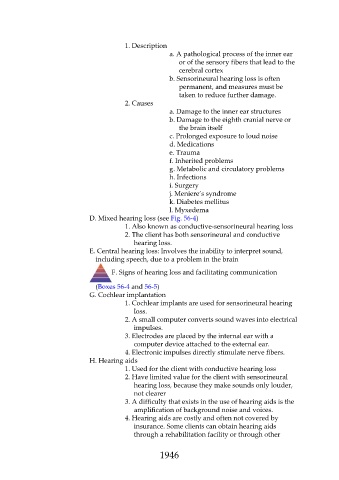Page 1946 - Saunders Comprehensive Review For NCLEX-RN
P. 1946
1. Description
a. A pathological process of the inner ear
or of the sensory fibers that lead to the
cerebral cortex
b. Sensorineural hearing loss is often
permanent, and measures must be
taken to reduce further damage.
2. Causes
a. Damage to the inner ear structures
b. Damage to the eighth cranial nerve or
the brain itself
c. Prolonged exposure to loud noise
d. Medications
e. Trauma
f. Inherited problems
g. Metabolic and circulatory problems
h. Infections
i. Surgery
j. Meniere’s syndrome
k. Diabetes mellitus
l. Myxedema
D. Mixed hearing loss (see Fig. 56-4)
1. Also known as conductive-sensorineural hearing loss
2. The client has both sensorineural and conductive
hearing loss.
E. Central hearing loss: Involves the inability to interpret sound,
including speech, due to a problem in the brain
F. Signs of hearing loss and facilitating communication
(Boxes 56-4 and 56-5)
G. Cochlear implantation
1. Cochlear implants are used for sensorineural hearing
loss.
2. A small computer converts sound waves into electrical
impulses.
3. Electrodes are placed by the internal ear with a
computer device attached to the external ear.
4. Electronic impulses directly stimulate nerve fibers.
H. Hearing aids
1. Used for the client with conductive hearing loss
2. Have limited value for the client with sensorineural
hearing loss, because they make sounds only louder,
not clearer
3. A difficulty that exists in the use of hearing aids is the
amplification of background noise and voices.
4. Hearing aids are costly and often not covered by
insurance. Some clients can obtain hearing aids
through a rehabilitation facility or through other
1946

